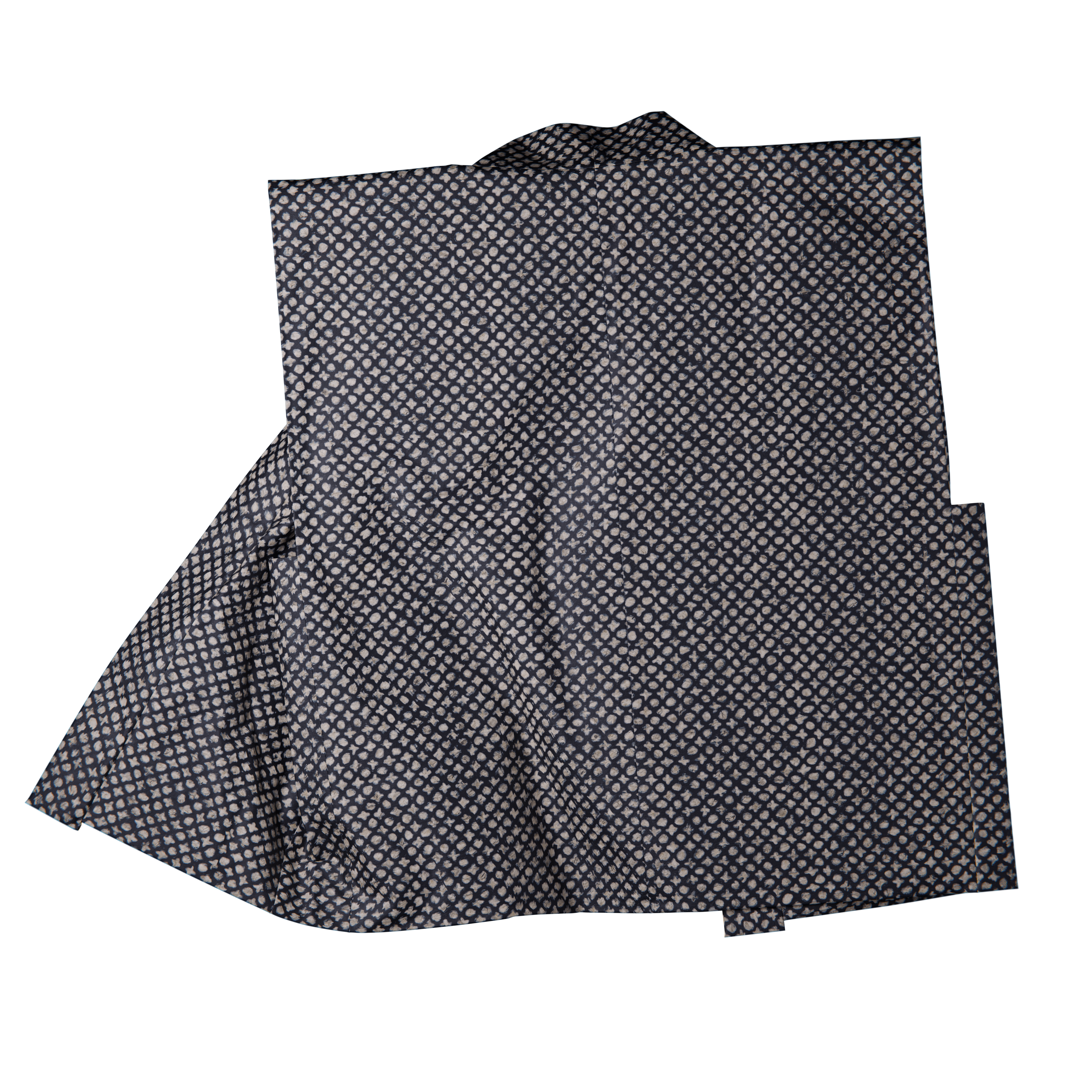author
Fukuda Paper Mills Ltd.year
20th centurycurrent location
ATOPOS cvc, Athens







Sodenashi
year
20th centurycurrent location
ATOPOS cvc, AthensA resist-dyed kamiko sodenashi-baori. This short, kimono-style jacket is called a sodenashi-baori, a haori with no sleeves. This garment is contemporary, likely mid-20th century, and was produced in a region in Tochigi Prefecture called Karasuyama, which is famous for producing high-quality Paper Mulberry, which is the most used raw material for washi paper and has been producing paper by hand for over 700 years. This garment may have been made to wear or been made to sell as a beautiful example of the local craft skills in the region for collectors. This garment is in excellent condition, and it has been stitched by hand and looks like it has not been worn.
A sodenashi (袖なし) is traditionally worn over a kimono or other clothing as a functional or decorative layer, especially in traditional Japanese fashion. The sodenashi vest can be part of both formal and casual outfits, depending on its design and material.
This piece is made from wrinkled handmade paper (momigami) and lined with likely cotton. It features a motif likely resist- or stencil-dyed with synthetic dye. It is evident that the garment was dyed, rather than printed, because the fibers have clearly been lifted and have dried in a manner tha suggests they have been wet; the motifs do not have crisp, clean edges as they would if it had been printed. The synthetic origin of the dye is indicated by a red spot visible in the dye. It has a cotton lining and is entirely hand stitched. The motif, though somewhat blurred, looks like Shippō (七宝), meaning “Seven Treasures”. This is a traditional Japanese motif often seen in various decorative arts, such as textiles, ceramics, and metalwork. The term originates from Buddhist scriptures, where it symbolizes the seven precious materials: gold, silver, lapis lazuli, crystal, agate, coral, and pearl. In design, Shippō refers to a circular, interlocking geometric pattern. When these circles overlap, they create shapes that resemble petals or leaves, forming an intricate, continuous pattern. The motif is commonly seen in kimono fabrics, pottery, and lacquerware, symbolizing infinite prosperity due to the never-ending, interlocking loops.
This piece came wrapped in its original packaging and came with a small slip of paper giving more details about it. Please find the transcription and translations below:
Slip of paper (Japanese):
通商産業大臣賞受賞
栃木県特産
鳥山和紙
本県の東北部に位し「蛇姫様」で広く世に知られている一鳥山ーは
那珂の清流に濃緑の山影が映える山水にめぐまれた風光絶佳の地で
あり、ここに古来より産出する手漉和紙は強靭と優雅をもって知ら
れております。
今より七百余年の昔、 須賀奉書を抄造したのが始まりであると伝えら
れ古くは程村、桟留、 十文字、西ノ内などの紙を産出し現在は障子紙、
西ノ内、半紙、傘紙、提灯紙、温床紙および工芸品紙などが主として生
産されております。
原料はガンピを使用いたしますので、製品は丈夫で持ちの良いことは
いうまでもありませんが、なおその特有の雅味は高く買われており
ます。
※※※
小社は
明治三十八年より和紙の製造、販売を業としかつては選挙投票用紙
として全国各府県に西ノ内紙を納め、各地の著名神社の御礼紙を納
入し、又障子紙、傘紙などは常に好評を持して来ました。特に程村、
西ノ内などの楮紙は博覧会、共進会などにおいて幾多の賞を受け、最近
は書簡箋、半画用紙など、民芸紙や、紙のれん、茶羽織、和紙押絵、
(額入)、各種袋物等の民芸品として国内はもちろん海外にも輸出
されます。 戦後昭和二十三年には内親王様に工場御高覧の栄に浴し
昭和二十九年には皇室御用紙抄造の光栄を得ました。
永年の伝統と最近の技術による各種製品は、書用者各位の御期特に
そえると存じます。
栃木県鳥山町
合名会社福田製紙所
電話(鳥山〇二八七八)二〇二八(営業所)
二一二八(工場)
Slip of paper (Japanese):
Minister of International Trade and Industry Prize
Tochigi Prefecture local specialty
Karasuyama Washi
Karasuyama, in the northern part of this prefecture, is widely-known as the location of the Princess of Snakes. This region has superb landscapes, rich with mountain water, where the Naka River’s clear streams and deep greens glisten in mountain shadows. Since time immemorial, the handmade washi paper made here has been known to be strong and refined.
For over 700 years, hodomura, santome, jūmonji, nichi no uchi [papers] are said to be the beginning of the production of Suga Hosho. Now, shoji paper, Nishi no uchi, hanshi, umbrella paper, lantern paper, paper used in seedling nurseries and other traditional craft papers are the main papers being produced.
The fiber is ganpi, which of course makes the paper strong and durable. This gives it a particular elegance which fetches a high price.
※※※
Since 1905, our company has been engaged in the manufacture and sale of washi paper and have also delivered Nishi-no-uchi-gami as election ballot paper to various prefectures throughout Japan, and our shoji paper and umbrella paper have always enjoyed a good reputation. Kozo paper from Hodomura village and Nishi no uchi in particular is exported domestically and internationally and has received numerous awards at expositions and competitions and has recently been used for letter paper and drawing paper and other folk-art paper, as well as paper curtains, tea haori, washi oshie (framed), various bag goods, etc,. After the war, the factory was honoured with a visit by Her Imperial Highness in 1948. In 1954, the company was honoured by the Imperial Household to produce paper for the Imperial Household. We make various products with long-established traditions and recent technology, and we believe that our products will meet the expectations of all calligraphers.
Toriyama-cho, Tochigi
Fukuda Paper Mills Ltd.
Telephone (Toriyama 00287)228 (sales office)
2128 (factory)
Outer packaging:
純楮和紙工芸
別誂 御袖なし羽織
栃木県烏山町
福田製紙所
謹製
Pure kōzo [Paper Mulberry] washi craft
Special order Sodenashi [sleeveless] Haori
Tochigi Prefecture, Karasuyama Town
Fukuda Seishi
Finest quality
Courtesy of ATOPOS cvc, Athens.
Research by Daphne Mohajer va Pesaran
Pattern making by Erisa Ibrahimi. 3D modelling by Martina Ponzoni. Texturing and rendering by Virgile Biosa.
